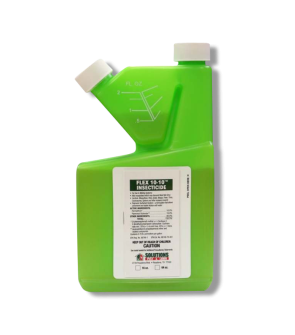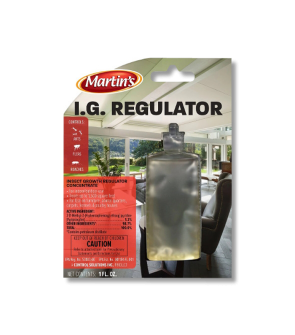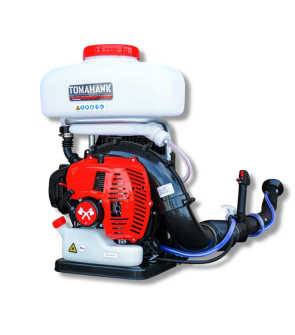Stable Fly Control
Most Effective Products
Stable Fly Control: How to Get Rid of Stable Flies
This page is a general stable fly control guide. Using the products and methods suggested you will get control of stable flies. Follow this guide and use the recommended products and we guarantee 100% control of stable flies.
Most animal owners are probably use to this sight: your livestock animal standing in a stall or the field, tail swishing, head swinging side to side, or occasional skin twitches. Stable flies, occasionally called barn fly, dog fly, lawn mower fly, or biting house fly are common pests during the late summer and fall months. These flies closely resemble house flies in appearance, but are their own species of flies with their own set of issues.
Stable flies prefer to feed on horses and cattle more than other animals, including people. When this blood meal source is not available they will feed on people and dogs. This biting fly feeds several times a day on animals, in which they pierce the skin numerous times before drawing blood causing a sharp pain.
The name "stable fly" suggests this pest is only an issue in stables, which is simply not the case. This pest achieved its name by consistently appearing where animals are kept due to the availability of fresh blood and manure for larvae. They are a common problem in both rural and suburban areas throughout the United States.
Due to intensive feeding from stable flies the afflicted animal can show reduce weight gain and for cows a reduction in milk production. Another issue this poses to outdoor livestock animals is that they will gather together to avoid the persistent feeding from this pest, which leads to possible heat stress. To protect yourself and your animals, then follow the steps and professional products listed throughout this DIY guide for effective stable fly control.
Identification
Before you can proceed with a treatment program, you will need to be certain the fly infesting your animals and property is a stable fly. Misidentification can lead you to using the wrong treatment methods and products, costing you time and money. Refer to the following characteristics to properly identify stable flies. A microscope may be needed to view the pest in detail.

- The stable fly resembles the house fly in appearance, but has a slender, pointed mouth part (proboscis) with which it pierces the hosts skin and sucks blood. Both the male and female stable fly feed on blood.
- Adult stable flies measure 7 to 8 mm (1/4 inch) long.
- Adult stable flies are light gray to brown in coloration with 4 horizontal dark strips on its thorax and dark spots on its abdomen, which resembles a checkerboard.
- Eggs are small measuring 1 mm long and have an off-white color. These eggs are shaped like a sausage and when present are gathered into clusters up to 50 eggs.
- Stable fly larvae have a standard maggot shape to them and go through three larvae stages. In the first stages of growth they are translucent measuring about 1.25 mm. In the last larvae stage of growth coloration switches from translucent to a pale yellow or creamy white coloration and develop a mouth hook with two posterior spiracles.
- After the third larvae stage of growth, stable fly larvae skin becomes hard and darken into a reddish brown color forming a capsule. Inside of this capsule also called a puparium, the larvae changes into a pupae. The pupae measures between 4.5 to 7 mm in length.
- Like the house fly, stable flies have widely spaced eyes.
Use the image and description above to help you correctly identify a stable fly. If you are unsure of the pest infesting your yard and animals, contact us through phone, email, or stop by in person at one of store locations for proper identification and recommended treatment control.
Inspection
Once you have identified stable flies, proceed with inspection. You are learning where stable flies are congregating or the decomposing materials that are attracting them. During this phase, you will focus on finding these problem areas around the home where stable flies are commonly found.

Where To Inspect
Stable flies need to breed in moist, decaying matter to create their larvae. In urban settings this could be pet droppings in yards or compost piles, garbage, or decomposing lawn clippings. In more rural areas this could be a build-up of waste from livestock or poultry in and around barns and pastures or any wet nutrient-rich matter such as hay bales, spilled animal feed, or animal bedding.
What To Look For
Stable flies are known for their voracious bites, which comes up in welts and are often itchy. Typically, they congregate around the animals legs, ankle, underside of the stomach, and flanks. Observe your animals for signs of irritation, foot stomping, tail swishing, animal bunching, or consistent shaking of body or head.
Treatment
Before implementing any pest control plan or handling any pesticide materials, you will need to wear the proper personal protective equipment (PPE).
Stable flies are most active in July to August, and September to October so applications with long residual insecticides combined with insect growth regulators will help to control immature and adult stable flies. Prevent breeding of future generations by performing regular sanitization practices before and during periods of activity.
Step 1: Sanitize Area to Minimize Attractants

Elimination of breeding sites is crucial as stable fly larvae feed and develop in decaying plant materials, often contaminated with animal waste. Animal waste, straw bedding, and grass clippings left unchanged for more than a week can start to decompose creating perfect conditions for female stable flies to lay eggs.
Effective control of stable flies in livestock areas and residential yards begins with an integrated approach, as insecticides cannot be successful until you remove the conditions allowing the pest to thrive.
On a weekly basis, regularly clean up any manure, hay, animal bedding, spilled feed, and other deteriorating organic materials from stalls, pens, paddocks, area under feeders, around fences, in and around barns, and other areas where animals are kept. Pay particular attention to wet and soiled straw bedding to aid in prevention of stable flies.
Move manure or compost piles at least several feet away from your barns or animal housing foundation and from areas where animals graze or are kept.
Step 2: Apply Residual Insecticide

Once all decaying organic matter has been removed, we recommend performing a space spray application with a pyrethroid product to treat flying pests and a residual to prevent flies from establishing themselves on any surfaces.
Flex 10-10 Insecticide is an emulsifiable concentrate made with permethrin 10% and piperonyl butoxide (PBO) 10% synergist that eliminates and repels pests like stable flies for up to 90 days. Once applied, it will eliminate and repel stable flies for up to 90 days.
Combine Flex 10-10 with Martin's IGR Insecticide to stop underdeveloped flies from maturing into reproductive adults. Martin's IGR Insecticide is an insect growth regulator that will effect the underdeveloped stages of stable flies that might be found in and around agricultural buildings like barns and on residential lawns.
Both of these products will need to be applied with an ULV fogger like the Tomahawk TMD14 Backpack Fogger to treat the air and any labeled surfaces in one application.
To treat stable flies, mix 64 fl. oz. of Flex 10-10 in 55 gallons of water to yield a solution of 0.09% concentration required for this pests control. This can be simplified down to 0.86 fl. oz. per 1 gallon of water. You will also need to mix in 1 fl. oz. of Martin's IGR Insecticide per 1 gallon of water.
Once your solution is mixed, apply as fog in the labeled areas. The particles will disperse through the air and settle onto any surfaces in the vicinity. When applying to shrubbery, be sure to treat over and underneath the leaves.
Before treating animal quarters, vacate the area and do not allow animals back in until the application dries completely. Flex 10-10 can be applied in dairy and beef barns, poultry houses, swine housing, warehouses, zoos, and other labeled animal housing. Do not apply to exposed feed and food, food stuffs, water, watering equipment, and do not treat cat bedding.
Stable flies that make contact with the fog will die quickly. When the product dries, it will leave behind a residual that lasts for up to 90 days. This application helps to treat mature flies that land on treated surfaces and prevent larvae from developing due to Martin's IGR Insecticide.
Treated areas should be thoroughly ventilated and dried before people and animals can reenter.
Prevention
Once you have reduced the presence of stable flies and ceased future generation development you must take preventative measures to ensure they do not return to your property. Listed below are some precautionary methods to prevent stable flies.

- On a regular basis, make sure to remove all decaying and moist, organic matter like manure, hay, grass clippings, pet droppings, and soaked animal bedding as stable flies find these ideal sites for egg laying activities. You will also need to relocate compost piles several feet away from your barns foundation and area where animals are kept for grazing.
- Mow turf when it reaches a height of 3 inches and weeds surrounding your home, barn, and animal housing area. Tall vegetation helps to increase shade and potential moisture issues whereas weeds steels nutrients away from other vegetation leading to wilting and decomposing plant materials.
- Properly remove pet droppings, manure, mowed grass clippings, and other pruned vegetation to reduce breeding sites for stable flies.
- Rake away fallen leaves and other plant debris in paddocks, pastures, lawns, and other areas where animals are kept. If left untreated, then manure and vegetation buildup helps to increase the stable fly habitat.
- Cover trash cans with sealable lids to prevent odors and decaying materials from attracting stable flies. Keep these garbage containers away from your animal housing and homes foundation.
- Install or repair screens in barn and home windows and doors.
- Apply Flex 10-10 Insecticide every 90 days to control adult stages of stable flies throughout the year. An additional application of Martin's IGR Insecticide can be made 14 days after the previous treatment or after heavy rainfall occurs.
Key Takeaways
What are Stable Flies?
- Stable flies are voracious blood-sucking filth flies that resemble the house fly, with the exception they bite people, livestock animals, and pets.
How to Get Rid of Stable Flies
- To control stable fly infestations, apply Flex 10-10 with Martin's IGR Insecticide as a space spray and residual treatment. Do not make these applications when animals or people are present nor allow them to return to treated areas until it is thoroughly ventilated and dried.
Preventing Stable Fly Reinfestations
- Prevent stable flies from returning to your property with regular sanitization practices such as removing manure, wet hay, grass clipping, and animal waste on a weekly basis. Continue to apply Flex 10-10 on a quarterly basis to control and prevent stable flies from returning to your property. Also, apply Martin's IGR Insecticide when 14 days has passed after the initial application.













































































































































































































































































































































































































































































































































